INTERNATIONAL
STANDARD
ISO
15622
Second edition
2010-04-15
Intelligent transport systems — Adaptive
Cruise Control systems — Performance
requirements and test procedures
Systèmes intelligents de transports — Systèmes stabilisateurs de
vitesse adaptés — Exigences de performance et modes opératoires
Reference number
ISO 15622:2010(E)
© ISO 2010
�
ISO 15622:2010(E)
PDF disclaimer
This PDF file may contain embedded typefaces. In accordance with Adobe's licensing policy, this file may be printed or viewed but
shall not be edited unless the typefaces which are embedded are licensed to and installed on the computer performing the editing. In
downloading this file, parties accept therein the responsibility of not infringing Adobe's licensing policy. The ISO Central Secretariat
accepts no liability in this area.
Adobe is a trademark of Adobe Systems Incorporated.
Details of the software products used to create this PDF file can be found in the General Info relative to the file; the PDF-creation
parameters were optimized for printing. Every care has been taken to ensure that the file is suitable for use by ISO member bodies. In
the unlikely event that a problem relating to it is found, please inform the Central Secretariat at the address given below.
COPYRIGHT PROTECTED DOCUMENT
© ISO 2010
All rights reserved. Unless otherwise specified, no part of this publication may be reproduced or utilized in any form or by any means,
electronic or mechanical, including photocopying and microfilm, without permission in writing from either ISO at the address below or
ISO's member body in the country of the requester.
ISO copyright office
Case postale 56 • CH-1211 Geneva 20
Tel. + 41 22 749 01 11
Fax + 41 22 749 09 47
E-mail copyright@iso.org
Web www.iso.org
Published in Switzerland
ii
© ISO 2010 – All rights reserved
�
ISO 15622:2010(E)
Contents
Page
Foreword ............................................................................................................................................................iv
Introduction.........................................................................................................................................................v
Scope......................................................................................................................................................1
1
2
Normative references............................................................................................................................1
Terms and definitions ...........................................................................................................................1
3
Symbols and abbreviated terms ..........................................................................................................3
4
4.1
Symbols..................................................................................................................................................3
4.2
Abbreviated terms .................................................................................................................................4
Classification .........................................................................................................................................5
5
5.1
Type of ACC systems............................................................................................................................5
5.2
Classification of curve capabilities .....................................................................................................5
Requirements.........................................................................................................................................5
6
Basic control strategy...........................................................................................................................5
6.1
6.2
Functionality ..........................................................................................................................................6
6.3
Basic driver interface and intervention capabilities ..........................................................................9
Operational limits ................................................................................................................................10
6.4
6.5
Activation of brake lights (ACC type 2 only)......................................................................................11
Failure reactions..................................................................................................................................11
6.6
7
Performance evaluation test methods ..............................................................................................12
Environmental conditions ..................................................................................................................12
7.1
Test target specification .....................................................................................................................12
7.2
7.3
Target acquisition range test (see 6.2.4.2)........................................................................................13
7.4
Target discrimination test (see 6.2.4.3) .............................................................................................14
7.5
Curve capability test (see 6.2.4.4) ......................................................................................................16
Annex A (normative) Technical information ..................................................................................................19
Bibliography......................................................................................................................................................25
© ISO 2010 – All rights reserved
iii
--```,,,`,``,```,,``````,````,,-`-`,,`,,`,`,,`---�
ISO 15622:2010(E)
Foreword
ISO (the International Organization for Standardization) is a worldwide federation of national standards bodies
(ISO member bodies). The work of preparing International Standards is normally carried out through ISO
technical committees. Each member body interested in a subject for which a technical committee has been
established has the right to be represented on that committee. International organizations, governmental and
non-governmental, in liaison with ISO, also take part in the work. ISO collaborates closely with the
International Electrotechnical Commission (IEC) on all matters of electrotechnical standardization.
International Standards are drafted in accordance with the rules given in the ISO/IEC Directives, Part 2.
The main task of technical committees is to prepare International Standards. Draft International Standards
adopted by the technical committees are circulated to the member bodies for voting. Publication as an
International Standard requires approval by at least 75 % of the member bodies casting a vote.
Attention is drawn to the possibility that some of the elements of this document may be the subject of patent
rights. ISO shall not be held responsible for identifying any or all such patent rights.
ISO 15622 was prepared by Technical Committee ISO/TC 204, Intelligent transport systems.
This second edition cancels and replaces the first edition (ISO 15622:2002) which has been technically
revised.
iv
© ISO 2010 – All rights reserved
--```,,,`,``,```,,``````,````,,-`-`,,`,,`,`,,`---�
ISO 15622:2010(E)
Introduction
The main system function of Adaptive Cruise Control is to control vehicle speed adaptively to a forward
vehicle by using information about: (1) ranging to forward vehicles, (2) the motion of the subject (ACC
equipped) vehicle and (3) driver commands (see Figure 1). Based upon the information acquired, the
controller (identified as “ACC control strategy” in Figure 1) sends commands to actuators for carrying out its
longitudinal control strategy and it also sends status information to the driver.
Subject vehicle
motion determination
Acquisition of
driver commands
Detection and ranging
of forward vehicles
ACC
control strategy
Actuators for
longitudinal control
Driver information
Environment
Vehicle
Driver
Figure 1 — Functional ACC elements
The goal of ACC is a partial automation of the longitudinal vehicle control and the reduction of the workload of
the driver with the aim of supporting and relieving the driver in a convenient manner.
This International Standard can be used as a system level standard by other standards, which extend the
ACC to a more detailed standard, e.g. for specific detection and ranging sensor concepts or higher level of
functionality. Therefore, issues like specific requirements for the detection and ranging sensor function and
performance or communication links for co-operative solutions will not be considered here.
© ISO 2010 – All rights reserved
v
�
--```,,,`,``,```,,``````,````,,-`-`,,`,,`,`,,`---�
INTERNATIONAL STANDARD
ISO 15622:2010(E)
Intelligent transport systems — Adaptive Cruise Control
systems — Performance requirements and test procedures
1 Scope
This International Standard contains the basic control strategy, minimum functionality requirements, basic
driver interface elements, minimum requirements for diagnostics and reaction to failure, and performance test
procedures for Adaptive Cruise Control (ACC) systems. Adaptive cruise control is fundamentally intended to
provide longitudinal control of equipped vehicles while travelling on highways (roads where non-motorized
vehicles and pedestrians are prohibited) under free-flowing traffic conditions. ACC can be augmented with
other capabilities, such as forward obstacle warning.
2 Normative references
The following referenced documents are indispensable for the application of this document. For dated
references, only the edition cited applies. For undated references, the latest edition of the referenced
document (including any amendments) applies.
ISO 2575, Road vehicles — Symbols for controls, indicators and tell-tales
UN/ECE Regulation No. 13-H, Uniform provisions concerning the approval of passenger cars with regard to
braking
3 Terms and definitions
For the purpose of this document, the following terms and definitions apply.
3.1
active brake control
function that causes application of the brake(s), not applied by the driver, in this case controlled by the ACC
system
3.2
Adaptive Cruise Control
enhancement to conventional cruise control systems [see Conventional Cruise Control (3.5)], which allows the
subject vehicle to follow a forward vehicle at an appropriate distance by controlling the engine and/or power
train and potentially the brake
3.3
brake
part in which the forces opposing the movement of the vehicle develop
NOTE 1
It can be a friction brake (when the forces are generated by friction between two parts of the vehicle moving
relatively to one another); an electrical brake (when the forces are generated by electro-magnetic action between two
parts of the vehicle moving relatively but not in contact with one another); a fluid brake (when the forces are generated by
the action of a fluid situated between two parts of the vehicle moving relatively to one another); an engine brake (when the
forces are derived from an artificial increase in the braking action, transmitted to the wheels, of the engine).
© ISO 2010 – All rights reserved
1
--```,,,`,``,```,,``````,````,,-`-`,,`,,`,`,,`---�
ISO 15622:2010(E)
NOTE 2
Adapted from UN ECE Regulation No. 13-H:1998, definition 2.6.
NOTE 3
For the purposes of this International Standard, transmission control devices are not considered as brakes.
3.4
clearance
distance from the forward vehicle's trailing surface to the subject vehicle's leading surface
3.5
Conventional Cruise Control
system capable of controlling the speed of a vehicle as set by the driver
3.6
forward vehicle
vehicle in front of and moving in the same direction and travelling on the same roadway as the subject vehicle
(3.11)
3.7
free-flowing traffic
smooth-flowing and heavy traffic excluding stop and go and emergency braking situations
3.8
time gap
τ
value calculated from vehicle speed v and clearance c by: τ = c/v
c
v
3.9
set speed
desired travel speed, set either by the driver or by some control system that is external to the ACC system
NOTE
The set speed is the maximum desired speed of the vehicle while under ACC control.
3.10
steady state
condition whereby the value of the described parameter does not change with respect to time, distance, etc.
3.11
subject vehicle
vehicle equipped with the system in question and related to the topic of discussion
3.12
ACC system states
For the purposes of this International Standard, three system states are distinguished (see Figure 2)
3.12.1
ACC off state
state in which direct access for activation of “ACC active state” is disabled
3.12.2
ACC stand-by state
state in which there is no longitudinal control by ACC system and the system is ready for activation by the
driver
2
© ISO 2010 – All rights reserved
�
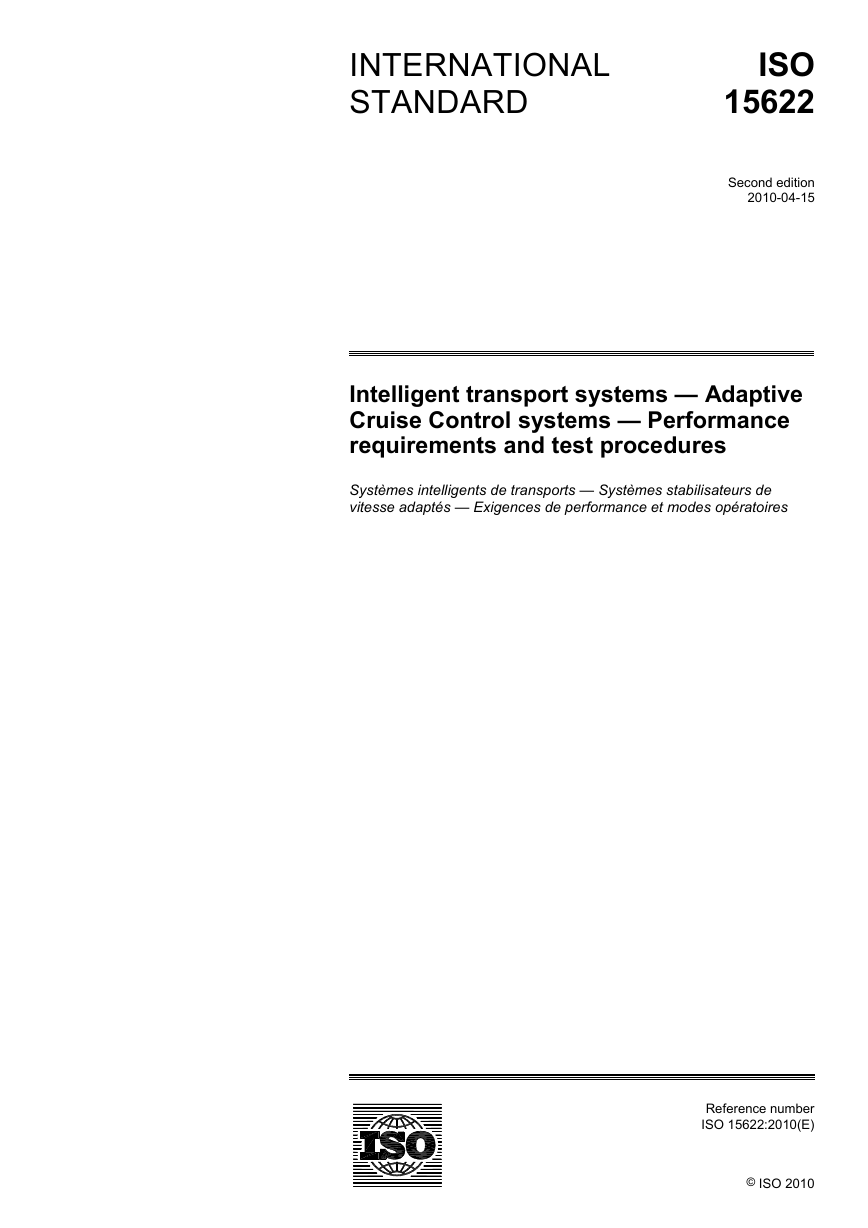
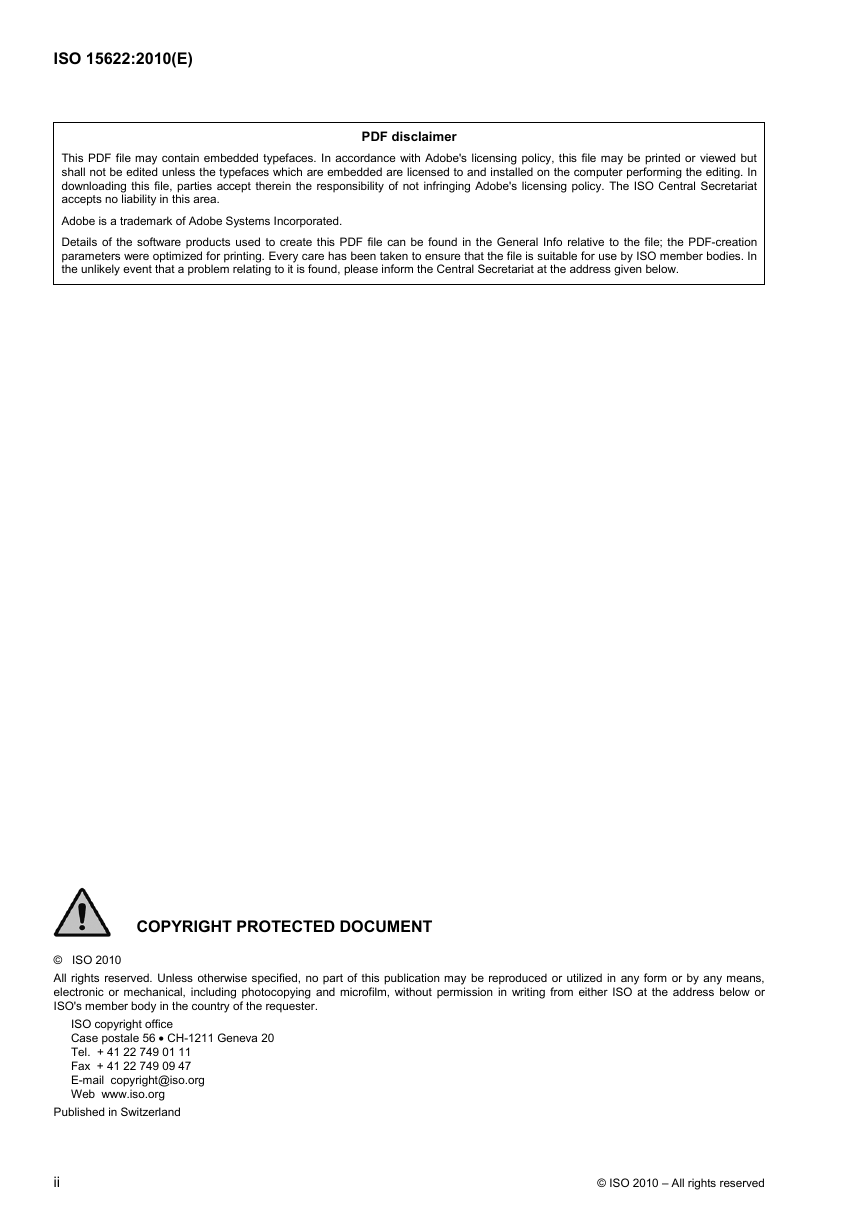
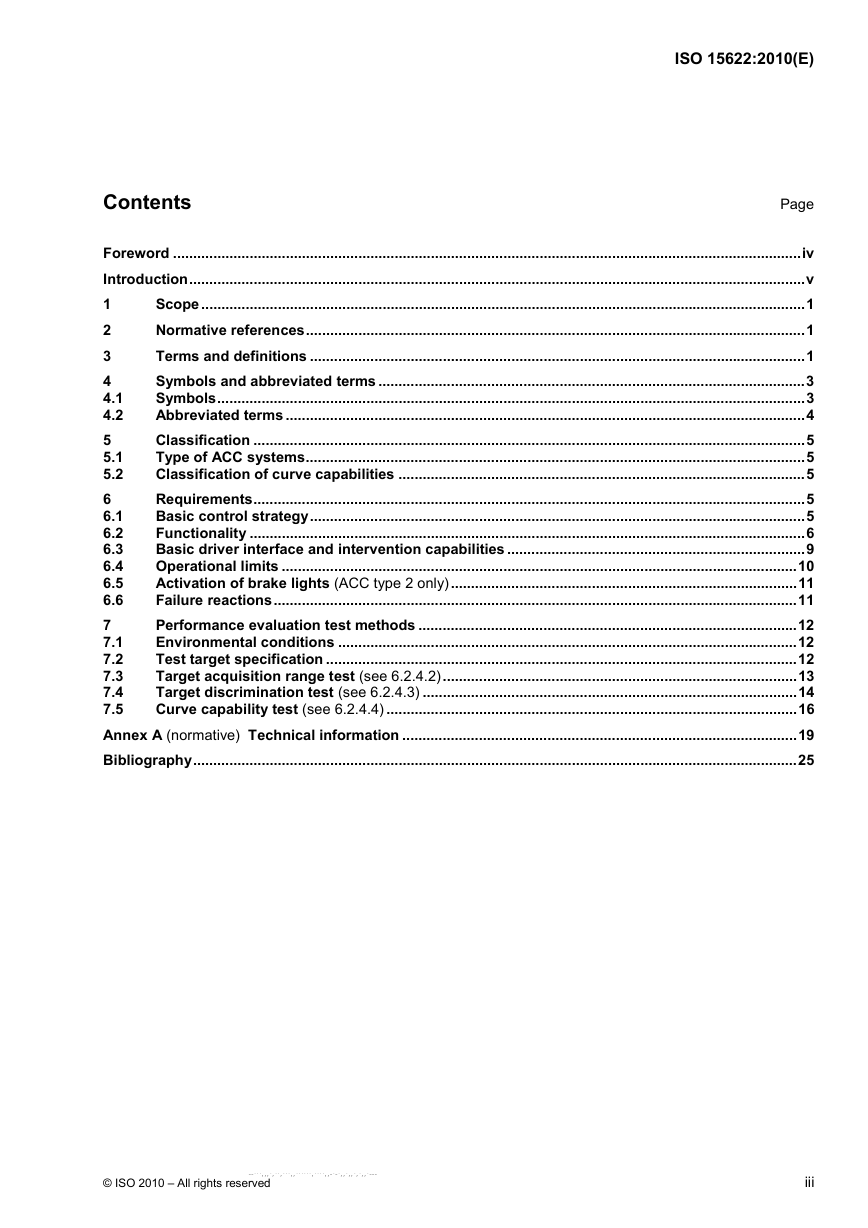
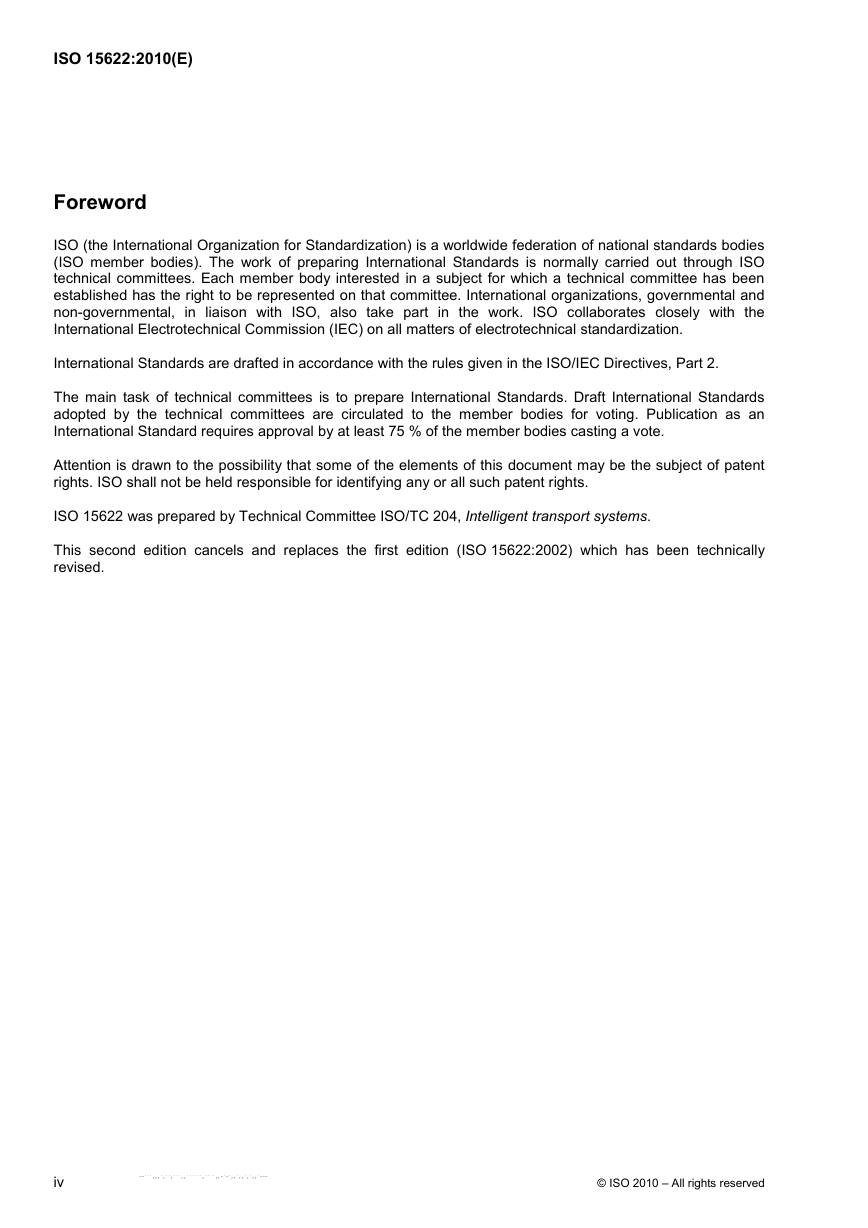
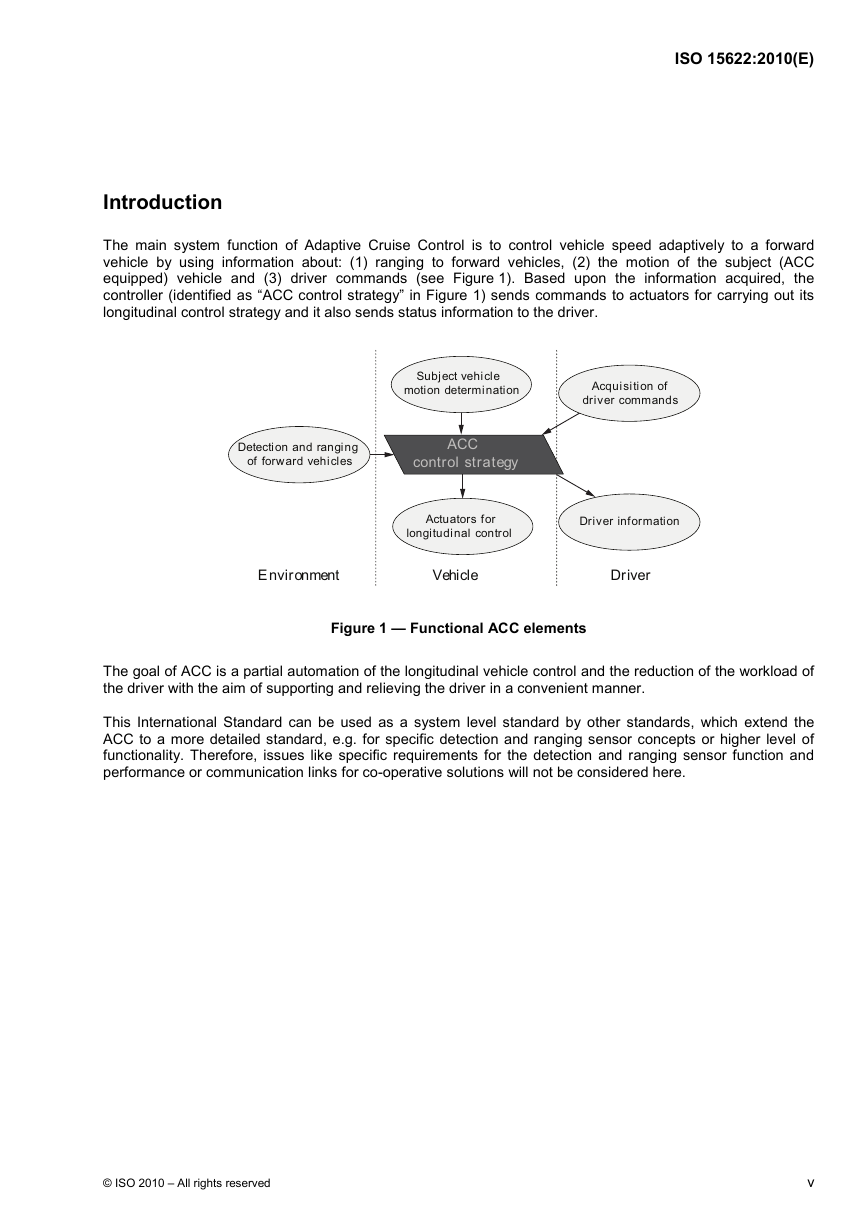

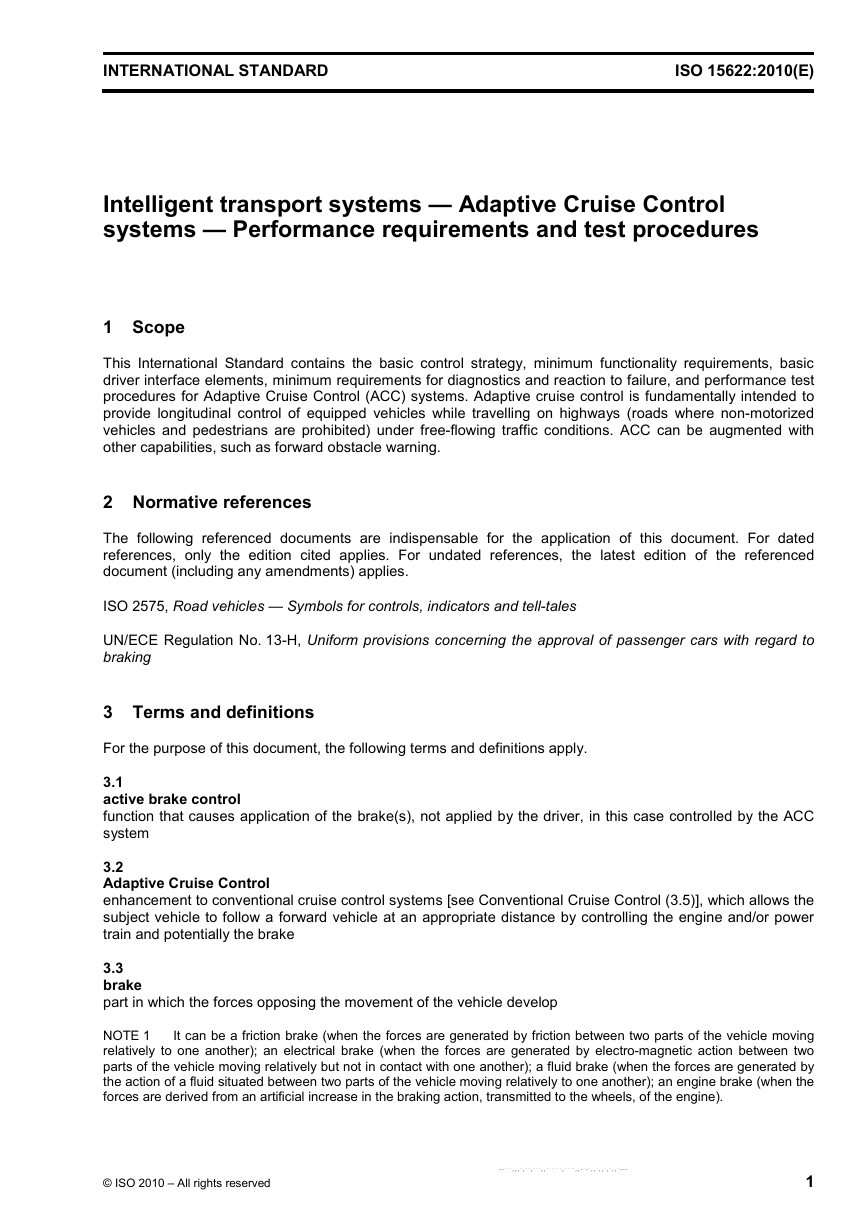









 2023年江西萍乡中考道德与法治真题及答案.doc
2023年江西萍乡中考道德与法治真题及答案.doc 2012年重庆南川中考生物真题及答案.doc
2012年重庆南川中考生物真题及答案.doc 2013年江西师范大学地理学综合及文艺理论基础考研真题.doc
2013年江西师范大学地理学综合及文艺理论基础考研真题.doc 2020年四川甘孜小升初语文真题及答案I卷.doc
2020年四川甘孜小升初语文真题及答案I卷.doc 2020年注册岩土工程师专业基础考试真题及答案.doc
2020年注册岩土工程师专业基础考试真题及答案.doc 2023-2024学年福建省厦门市九年级上学期数学月考试题及答案.doc
2023-2024学年福建省厦门市九年级上学期数学月考试题及答案.doc 2021-2022学年辽宁省沈阳市大东区九年级上学期语文期末试题及答案.doc
2021-2022学年辽宁省沈阳市大东区九年级上学期语文期末试题及答案.doc 2022-2023学年北京东城区初三第一学期物理期末试卷及答案.doc
2022-2023学年北京东城区初三第一学期物理期末试卷及答案.doc 2018上半年江西教师资格初中地理学科知识与教学能力真题及答案.doc
2018上半年江西教师资格初中地理学科知识与教学能力真题及答案.doc 2012年河北国家公务员申论考试真题及答案-省级.doc
2012年河北国家公务员申论考试真题及答案-省级.doc 2020-2021学年江苏省扬州市江都区邵樊片九年级上学期数学第一次质量检测试题及答案.doc
2020-2021学年江苏省扬州市江都区邵樊片九年级上学期数学第一次质量检测试题及答案.doc 2022下半年黑龙江教师资格证中学综合素质真题及答案.doc
2022下半年黑龙江教师资格证中学综合素质真题及答案.doc